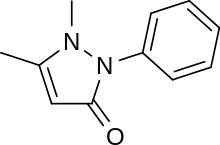Phenazone
 | |
| Clinical data | |
|---|---|
| ATC code | |
| Pharmacokinetic data | |
| Biological half-life | 12 hours |
| Identifiers | |
| |
| Synonyms | analgesine, antipyrine |
| CAS Number | |
| PubChem CID | |
| DrugBank | |
| ChemSpider | |
| UNII | |
| KEGG | |
| ChEBI | |
| ChEMBL | |
| ECHA InfoCard | 100.000.442 |
| Chemical and physical data | |
| Formula | C11H12N2O |
| Molar mass | 188.2258g/mol |
| 3D model (JSmol) | |
| |
| |
| (verify) | |
Phenazone (INN and BAN; also known as phenazon, antipyrine (USAN), or analgesine) is an analgesic, a nonsteroidal anti-inflammatory drug (NSAID) and an antipyretic. It was first synthesized by Ludwig Knorr in 1887.[1][2]:26–27 Phenazone is synthesized[3] by condensation of phenylhydrazine and ethyl acetoacetate under basic conditions and methylation of the resulting intermediate compound 1-phenyl-3-methylpyrazolone[4] with dimethyl sulfate or methyl iodide. It crystallizes in needles which melt at 156 °C. Potassium permanganate oxidizes it to pyridazine tetracarboxylic acid. Phenazone has an elimination half life of about 12 hours.[5] Indication: Used to relieve pain and fever. Antipyrine is often used in testing the effects of other drugs or diseases on drug-metabolizing enzymes in the liver.[6]
Adverse effects
Possible adverse effects include:
See also
- Propyphenazone
- A/B Otic Drops, ear drops combined with benzocaine to relieve pain and remove cerumen
References
- ↑ Brune, K (1997). "The early history of non-opioid analgesics". Acute Pain. 1: 33. doi:10.1016/S1366-0071(97)80033-2.
- ↑ Enrique Ravina. The Evolution of Drug Discovery: From Traditional Medicines to Modern Drugs. John Wiley & Sons, 2011 ISBN 9783527326693
- ↑ https://books.google.ca/books?id=07g30rxCA0EC&lpg=PA225&ots=KjJPobMfjq&dq=synthesis%20of%20phenazone&pg=PA226#v=onepage&q=synthesis%20of%20phenazone&f=false
- ↑ http://www.chemspider.com/Chemical-Structure.63516.html
- ↑ http://www.mims.com/USA/drug/info/phenazone/?q=Other%20Ear%20Preparations&type=full
- ↑ http://www.medicatione.com/?c=ing&s=antipyrine
External links
-
 Chisholm, Hugh, ed. (1911). "Antipyrine". Encyclopædia Britannica. 2 (11th ed.). Cambridge University Press. p. 134.
Chisholm, Hugh, ed. (1911). "Antipyrine". Encyclopædia Britannica. 2 (11th ed.). Cambridge University Press. p. 134.